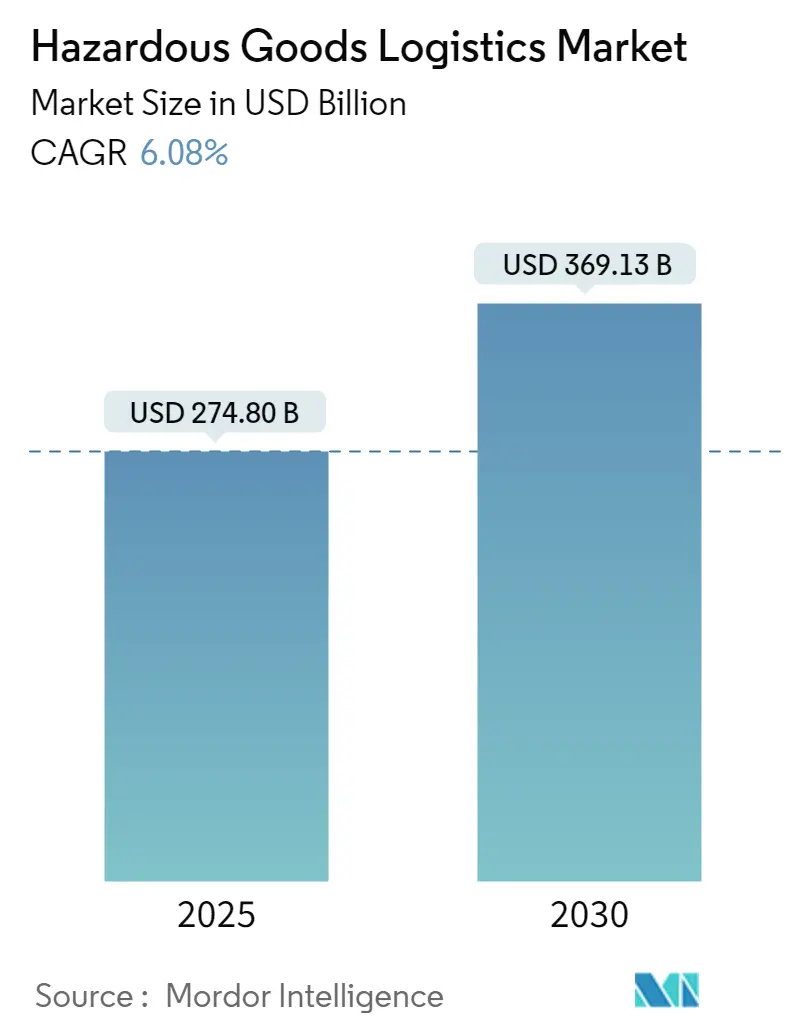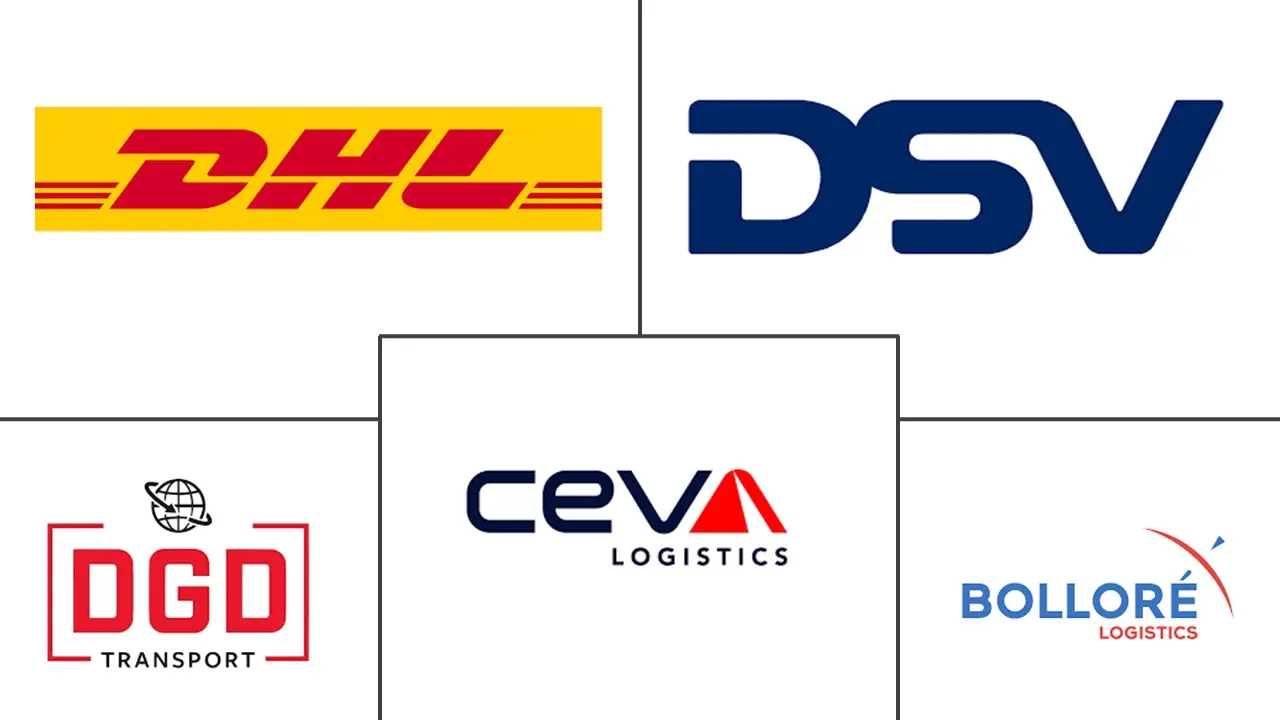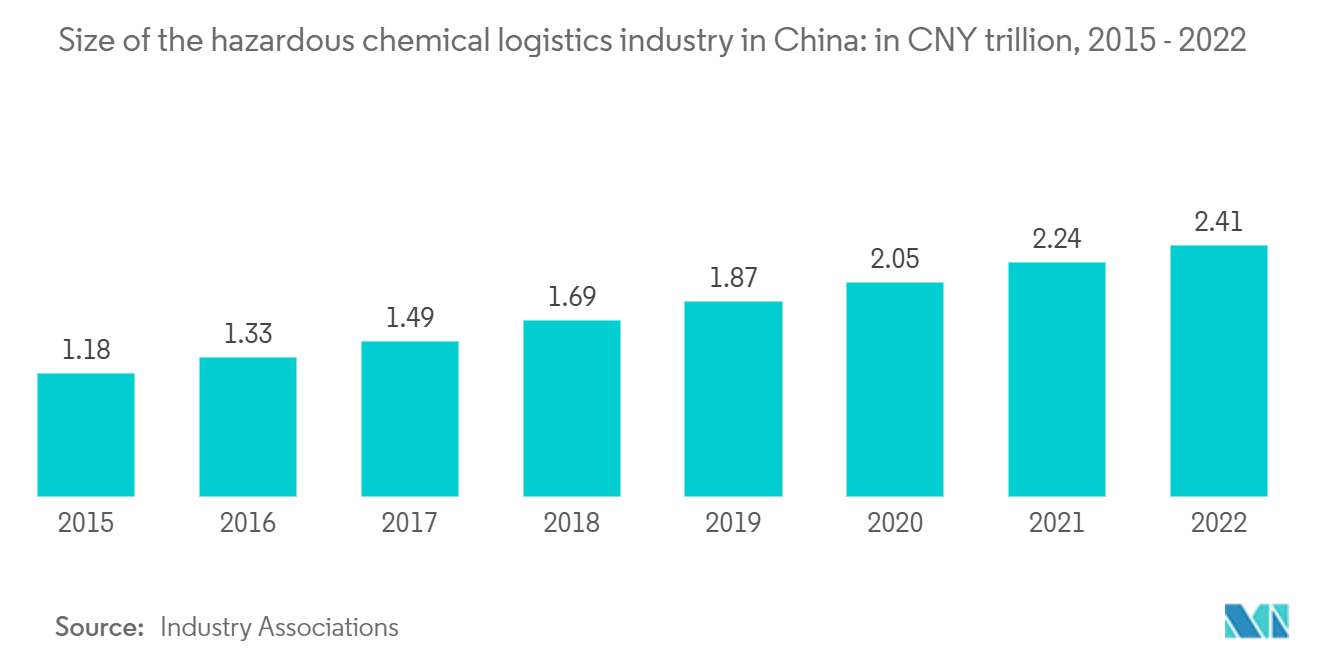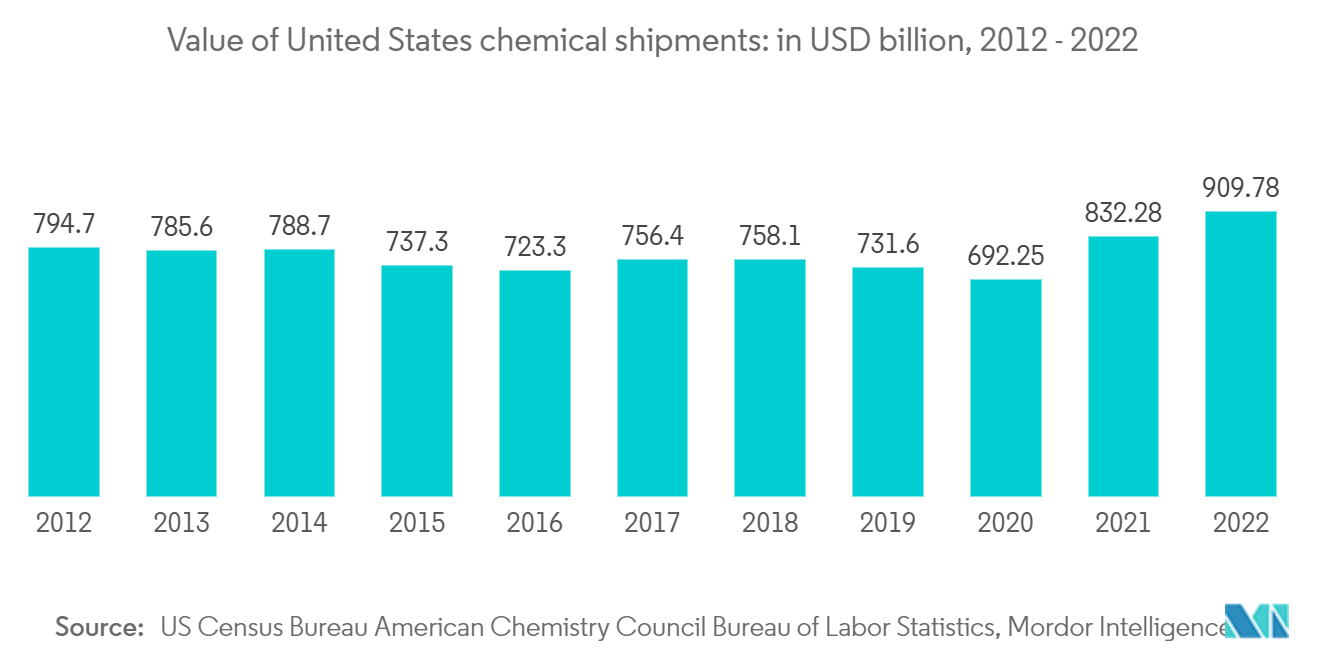
| Study Period | 2020 - 2030 |
| Market Size (2025) | USD 274.80 Billion |
| Market Size (2030) | USD 369.13 Billion |
| CAGR (2025 - 2030) | 6.08 % |
| Fastest Growing Market | Asia-Pacific |
| Largest Market | North America |
| Market Concentration | Low |
Major Players
*Disclaimer: Major Players sorted in no particular order |
Hazardous Goods Logistics Market Analysis
The Hazardous Goods Logistics Market size is estimated at USD 274.80 billion in 2025, and is expected to reach USD 369.13 billion by 2030, at a CAGR of 6.08% during the forecast period (2025-2030).
When shipping large quantities of hazardous materials, government agencies require accurate labeling of each product to comply with federal regulations. In 2003, the UN adopted a global system for identifying hazardous materials that may pose physical, health, and environmental risks. Dangerous materials are classified into nine hazard categories: flammable, corrosive, and gaseous. The UN number is a required four-digit number ranging from 0004 to 3548 that identifies specific dangerous goods and hazardous materials for international transportation.
Risky materials comprise the bulk of international cargo, containing many commonly used products and items. Much of this cargo reportedly consists of gasoline and other petroleum products. The current oil boom may result from unprecedented growth over the past few years due to hydraulic fracturing and a government fostering a more conducive environment for fuel production. The United States produces the bulk of the world's oil.
The requirement to ship dangerous goods is anticipated to increase yearly, in addition to the numerous hazardous goods rules being updated annually. The need for UN packaging, training, labels, and placards will rise due to the growing requirement to move lithium batteries and the region's well-established gas and oil businesses, driving the dangerous goods market to record highs.
Additionally, all forms of transportation must be used to convey radioactive medication, virus samples, healthcare hazardous chemicals, and clinical waste such as surgical equipment. For example, the oil and gas industry may impact this expected expansion of dangerous goods around the globe. The oil and gas industry, which is still lucrative, is anticipated to receive investments totaling USD 237 billion over the next 10 years, or 25% of the estimated worldwide investment in this industry.
Hazardous Goods Logistics Market Trends
Increase in Shipment of Flammable Liquids Driving the Market
The medical, nuclear power, oil and gas, and petrochemical industries are examples of the widespread use of hazardous materials in developing or developed economies. Transport companies transporting dangerous goods must follow standard procedures for the safety of their vehicles and vessels. Other federal agencies' regulations on dangerous products, workplace safety, and environmental protection also apply.
Over the next few years, the hazardous product logistics market will benefit significantly from increasingly strict government regulations. The US Department of Transportation’s (DOT) Pipeline and Hazardous Materials Safety Administration (PHMSA) is responsible for developing and implementing national regulations for the safe transport of dangerous goods. When transporting dangerous goods to, from, or within the United States, it is critical to comply with the Hazardous Materials Regulations (HMR 49, Part 100-185).
The UN Model Regulations for the carriage of dangerous goods serve as a reference for the development of standardized regulations for all modes of transport. There is a new edition every two years. In order to facilitate trade and facilitate the safe and efficient transportation of dangerous products, labels or marks specifically designed for the carriage of dangerous commodities on cargo vessels must be applied to the dangerous goods. More importantly, they help make transportation safer.
Asia-Pacific Dominates the Market
The Capacity Building Course on Promoting Safety for Dangerous Goods Transportation in the APEC Region, including the workshop, was held online in Phuket from December 1 to 2, 2022. The course was attended by a total of 53 participants from 11 APEC member economies, namely China, Japan, the Republic of Korea, Malaysia; Peru, the Philippines, Singapore, Chinese Taipei, Thailand, the United States; and Vietnam and three Non-APEC economies, namely Cambodia, Sri Lanka, and France, as well as representatives of relevant international organization, regional agencies, port authorities, universities, research institutes, professional associations, and private sectors.
In the fiscal year 2022, the total number of dangerous goods containers in Bangkok Port was 38,545 TEUs. The highest number of hazardous goods containers was in Class 9 (14,034 TEUs), followed by Class 3 (9,489 TEUs). At the same time, the lowest number of dangerous goods containers was in Class 6.1 (3,083 TEUs). Similarly, the total number of hazardous goods containers in Laem Chabang Port was 174,938 TEUs. The highest number of dangerous goods containers was in Class 9 (59,734 TEUs), followed by Class 3 (42,606 TEUs).
Large-scale petrochemical development has decreased the gasoline demand. As a result, more dangerous goods, such as oil and gas, are being transported across the country using trucking services.
The United States is projected to become the largest oil producer in the world within the next five years, overtaking both Saudi Arabia and Russia. Shipping companies are essential for the oil and gas industry to get their goods to customers worldwide. These market trends should lead to the expansion of the hazardous goods logistics market. Applicable laws and regulations should package dangerous materials. It is also important to use labels or other identifying indicators on cargo carriers when transporting hazardous materials. This would significantly enhance transit security.

Hazardous Goods Logistics Industry Overview
The hazardous goods logistics market is fragmented, with a mixture of global and local players. Some of the strong players include DHL, DSV, Ceva Logistics, Bollore Logistics, and DGD Transport. Contracts, collaborations, joint ventures, and partnerships are among many other strategies these players have implemented to stay ahead of the competition and meet the expanding needs of their clients.
Also, they engage in research and development operations to strengthen their portfolios and gain market share. The capabilities of local players in terms of technology, items handled, service offered, and inventory management are all improving. With the tightening of hazardous goods logistics regulations, many freight forwarding businesses that can independently provide dangerous competent goods logistics full-chain services have emerged.
Hazardous Goods Logistics Market Leaders
-
DHL
-
DSV
-
Ceva Logistics
-
Bollore Logistics
-
DGD Transport
- *Disclaimer: Major Players sorted in no particular order

Hazardous Goods Logistics Market News
- September 2023: BlackBerry Limited revealed that it introduced the H2M IS line of BlackBerry Radar® devices, which are intended for carriers of hazardous materials. An 'Intrinsically Safe' certification designation supports the new series, allowing BlackBerry Radar, an asset tracking solution, to target logistics and transportation industries that move hazardous goods, such as railroads, fuel haulers, tank carriers, and ocean shipping lines.
- June 2023: Transport Canada granted Drone Delivery Canada Corp. (DDC) authorization to conduct Beyond Visual Line-of-sight (BVLOS) flights in conjunction with conveying hazardous materials for its Care by Air drone route. According to DDC, this is a critical turning point in the growth of its drone delivery capabilities inside the healthcare industry. Deliver Canada authorizes DDC to deliver Class 7 dangerous items through BVLOS flights over the Golden Horseshoe and Southern Ontario region.
Hazardous Goods Logistics Industry Segmentation
Corrosive, flammable, explosive, spontaneously combustible, poisonous, oxidizing, or water-reactive compounds are hazardous. Logistics refers to managing how resources are acquired, stored, and transported to the final destination. A complete background analysis of the hazardous goods logistics market, including the assessment of the economy and contribution of sectors in the economy, market overview, market size estimation for key segments, and emerging trends in the market segments, market dynamics, and geographical trends, and the COVID-19 impact, is covered in the report.
The hazardous goods logistics market is segmented by service (transportation, warehousing and distribution, and value-added services), destination (domestic and international), and geography (Asia-Pacific, North America, Europe, Latin America, and Middle East and Africa). The report offers market size and forecasts for all the above segments in value (USD).
| By Service | Transportation |
| Warehousing and Distribution | |
| Value-added Services | |
| By Destination | Domestic |
| International | |
| By Geography | Asia-Pacific |
| North America | |
| Europe | |
| Latin America | |
| Middle East and Africa |
Hazardous Goods Logistics Market Research FAQs
How big is the Hazardous Goods Logistics Market?
The Hazardous Goods Logistics Market size is expected to reach USD 274.80 billion in 2025 and grow at a CAGR of 6.08% to reach USD 369.13 billion by 2030.
What is the current Hazardous Goods Logistics Market size?
In 2025, the Hazardous Goods Logistics Market size is expected to reach USD 274.80 billion.
Who are the key players in Hazardous Goods Logistics Market?
DHL, DSV, Ceva Logistics, Bollore Logistics and DGD Transport are the major companies operating in the Hazardous Goods Logistics Market.
Which is the fastest growing region in Hazardous Goods Logistics Market?
Asia-Pacific is estimated to grow at the highest CAGR over the forecast period (2025-2030).
Which region has the biggest share in Hazardous Goods Logistics Market?
In 2025, the North America accounts for the largest market share in Hazardous Goods Logistics Market.
What years does this Hazardous Goods Logistics Market cover, and what was the market size in 2024?
In 2024, the Hazardous Goods Logistics Market size was estimated at USD 258.09 billion. The report covers the Hazardous Goods Logistics Market historical market size for years: 2020, 2021, 2022, 2023 and 2024. The report also forecasts the Hazardous Goods Logistics Market size for years: 2025, 2026, 2027, 2028, 2029 and 2030.
Our Best Selling Reports
Hazardous Goods Logistics Industry Report
Statistics for the 2025 Hazardous Goods Logistics market share, size and revenue growth rate, created by Mordor Intelligence™ Industry Reports. Hazardous Goods Logistics analysis includes a market forecast outlook for 2025 to 2030 and historical overview. Get a sample of this industry analysis as a free report PDF download.





